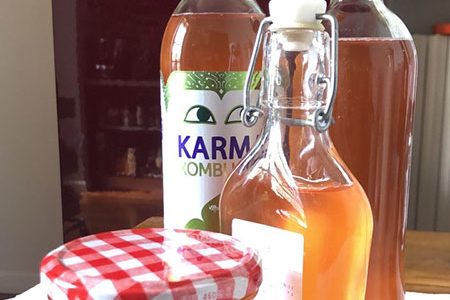In recent years it has become super popular, leading many companies to start producing and selling fermented tea. We are talking about Kombucha
Kombucha, the fermented tea that has been popular on social media for some years.
It must be said that there is a slight difference between those we find on the market and the one produced at home: those on sale are all quite sweet and have a slightly less acid taste than homemade Kombucha.
Starting to produce Kombucha at home is not complicated at all and will give you great satisfaction.
How to use the Scuby
Kombucha is, in essence, a sweetened tea (usually starting from a mix of green tea and black tea leaves, preferable to ready-made tea bags) that is fermented through a Scoby (a cellulose disc), an English acronym which translated means Symbiotic Community of Bacteria and Yeast, Symbiotic Culture of Bacteria and Yeast.
To start making home-brewed tea you will need to get one or more Scobys.
If you have friends who produce it, you can ask for a Scoby as a gift. Or, alternatively, there are many groups on FB, exchange sites and other social networks that favor the Scoby donation in exchange for a small cash offer, an amount that will be donated to charity.
If you can't find a Scoby easily, you can buy certified organic ones online.
The quality of the tea is essential for making Kombucha. So no tea bags, which often release small pieces of paper or nylon during the infusion. You can buy excellent tea in organic shops, in those that sell spices and seeds and also in specialized online stores. The sugar used is usually the granulated one.
Kombucha is quite routine and changing the ingredients is not always good: if you start fermenting tea with granulated sugar, continue with that. After starting the first fermentations to have had some experience in the preparation, you can also experiment with different recipes of Kombucha: with Rooibos (also called red tea), with Karkadè, with coffee, or with only green tea for produce the Yun. These obviously will have to be prepared with new Scobys. Remember that each fermentation must have its own Scoby and for no reason should they be mixed and used for other uses.
Once the tea has begun to ferment, and with each new fermentation, you will end up with a new Scoby: you can use it for new experiments or store it in a fairly large jar, usually called the Scoby hotel. The Scoby hotel will always have to be fed new fermented tea to feed the Scobys.
This will give you new Scobys to give as gifts or to use for other experiments.
Kombucha
Ingredients
Natural water, but not that from the municipal aqueduct (in short, from the tap, to understand) and not even filtered water.
Dose per liter of water
Green tea 3 g + black tea 2 grams (not in sachets, must be of excellent quality), for a total of 5 g tea; granulated sugar, if fine it is better (not cane, not whole) from 60/70 g to 100 g; the percentage of starter (Kombucha) is 10% per liter, but even more can be used. A bit like mother yeast, at each refreshment you have to keep fermented tea aside to start fermentation.
Equipment
A 2-4 liter pot to boil the water, a glass / ceramic container to cool (2-4 liters); a very large glass jar (burnie or preserving jars are perfect) for at least 2/4 liters of capacity; a thermometer; a cotton or linen muslin; a clean napkin or handkerchief to put on top of the vase; a large rubber band that will have to be fixed on the vase.
Method
To start, start with 2 liters of water: bring the water to a boil up to a temperature of about 80/85 °; turn off the heat, put the tea and leave to infuse for 10-15 minutes. Strain the tea through a sieve, add sugar and dissolve well. Wait until the tea reaches a temperature of 20 °, maximum 25 °; a blast chiller can be used to speed up the cooling process. Transfer the tea to the glass jar, add the Kombucha starter and the Scoby.
Each week another thin layer of cellulose, yeast and bacteria will form, a new Scoby.
The advice is to start tasting Kombucha every day, so as to understand its evolution.
The glass jar must be at a temperature between 22 ° and 28 °, but it must not drop below 20 ° and not rise above 30 ° so pay attention to where you place it (always better not in the sun, but in a place of kitchen that has enough shade).
Always use latex gloves to touch and move the Scoby. Bare hands, even if very well washed, can have small cuts, microbes / bacteria under the nails. There is a risk of contaminating the tea.
You can start experimenting with continuous fermentation with a very large glass jar, equipped with a tap, so you don't have to move the Scoby every time; just add the sweetened tea to each new fermentation.
This recipe has already been read 466 times!
